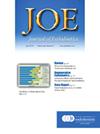Effect of Novel and Traditional Intracanal Medicaments on Biofilm Viability and Composition
IF 3.5
2区 医学
Q1 DENTISTRY, ORAL SURGERY & MEDICINE
引用次数: 0
Abstract
Introduction
The aim of this study was to test the hypothesis that a combination of D-amino acids (DAAs) and trans-cinnamaldehyde (TC) demonstrates superior antibiofilm activity to calcium hydroxide (CH) and untreated controls.
Methods
In this 3-part in vitro study, the concentration of DAAs (D-methionine, D-leucine, D-tyrosine, and D-tryptophan) that would significantly decrease Enterococcus faecalis and Actinomyces naeslundii biofilm biomass was first determined. Then, the effect of TC + selected DAAs on polymicrobial biofilms was characterized by quantifying the biomass and biofilm viability. Finally, the antibiofilm effects of TC + DAA was compared with CH and untreated controls by (i) determining bacterial viability and (ii) quantifying biofilm matrix composition using selective fluorescence-binding analysis. Statistical analysis was performed using one-way ANOVA and appropriate multiple comparisons test, with P < .05 considered as statistically significant.
Results
TC (0.06%) + D-tyrosine (1 mM) + D-tryptophan (25 mM) significantly reduced the biomass and biofilm viability compared to the control (P < .05). While no significant difference was observed between TC + DAA and CH in the cultivable bacterial counts (P > .05), confocal microscopy demonstrated a significantly greater percentage of dead bacteria in TC + DAA-treated biofilms compared to CH and the control (P < .05). TC + DAA significantly decreased the biovolume and all the examined components of the biofilm matrix quantity compared to the control, while CH significantly reduced only the exopolysaccharide quantity (P < .05).
Conclusion
The combination of TC + D-tyrosine + D-tryptophan demonstrated superior antibiofilm activity (biofilm bacterial killing and reduction of matrix quantity) to CH and has potential to be developed as an intracanal medicament.
新型和传统龈内药物对生物膜活力和组成的影响
简介:本研究旨在验证一种假设,即 D-氨基酸(DAA)和反式肉桂醛(TC)的组合比氢氧化钙(CH)和未处理的对照组具有更强的抗生物膜活性:在这项由三部分组成的体外研究中,首先确定了能显著降低粪肠球菌和奈氏放线菌生物膜生物量的 DAA(D-蛋氨酸、D-亮氨酸、D-酪氨酸和 D-色氨酸)浓度。然后,通过量化生物量和生物膜活力,确定了 TC + 所选 DAAs 对多微生物生物膜的影响。最后,通过(i)确定细菌存活率和(ii)使用选择性荧光结合分析量化生物膜基质组成,将 TC+DAA 的抗生物膜效果与 CH 和未处理的对照组进行比较。统计分析采用单因素方差分析和适当的多重比较检验,结果如下:与对照组相比,TC(0.06%)+ D-酪氨酸(1 mM)+ D-色氨酸(25 mM)显著降低了生物量和生物膜活力(P.05),共聚焦显微镜显示,与 CH 和对照组相比,TC+DAA 处理的生物膜中死亡细菌的比例显著增加(PConclusion:TC + D-酪氨酸 + D-色氨酸的抗生物膜活性(杀灭生物膜细菌和减少基质数量)优于 CH,具有开发为龋内药物的潜力。
本文章由计算机程序翻译,如有差异,请以英文原文为准。
求助全文
约1分钟内获得全文
求助全文
来源期刊

Journal of endodontics
医学-牙科与口腔外科
CiteScore
8.80
自引率
9.50%
发文量
224
审稿时长
42 days
期刊介绍:
The Journal of Endodontics, the official journal of the American Association of Endodontists, publishes scientific articles, case reports and comparison studies evaluating materials and methods of pulp conservation and endodontic treatment. Endodontists and general dentists can learn about new concepts in root canal treatment and the latest advances in techniques and instrumentation in the one journal that helps them keep pace with rapid changes in this field.
 求助内容:
求助内容: 应助结果提醒方式:
应助结果提醒方式:


